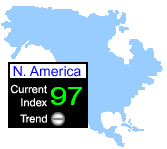Space Shuttle Discovery Landing Forecast
For those of you who care, here is a link to the Spaceflight Meteorology Group's forecast.
Since this is loaded with all of the standard NWS product jargon (some of the SPC products raise abbreviation writing to an art form), I will make a translation when it gets closer to landing (landing forecasts are only two days in advance. In the meantime, you can enjoy the more digestable NWS point forecasts for each site: Kennedy Space Center (Cape Canaveral, Florida), Edwards Air Force Base (California), and White Sands (New Mexico).
Changes to original post in RED.METAR KRDU 100351Z 18002KT 10SM SCT200 22/17 A3011 RMK SLP192Labels: meteorology, space





4 Comments:
And I thought I had it rough trying to translate Japanese info 'properly' to enter it in anidb for 'NHK ni Youkoso' :)
Ha ha. That reminds me, small fact.. I don't believe the military has ever had any space launching issues.
Know why?
Because they go by the book. If its one degree too hot (or cold) they pack up the satellite and don't launch.
As for NASA, they're commercial. And I believe that explains enough.
^_^;
(no, I don't have anything against NASA)
The actual SPC convective outlooks have actually gotten slightly close to readable English, see for example the Day 1 Convective Outlook, and compare it to the absolute gibberish at the bottom of the Convective Outlook Areal Outlines for Day 1, Day 2, and Day 3.
METAR KRDU 110251Z 18005KT 7SM FEW250 26/19 A3013 RMK SLP201
So those outlooks are computer generated right...
I mean they don't have monkeys sitting in a room typing up those things do they? No wait, they do don't they. O:)
They sort of are computer generated. Someone does manually draw the lines based on the modelling data's probablistic risks for given threats and their meteorological analysis (for example, high winds require higher threshholds than tornadoes for specific criteria), but the NWS's system then translates the lines into coordinates.
METAR KRDU 140051Z 18009KT 10SM SCT050TCU BKN150 OVC250 31/23 A3003 RMK SLP163
Post a Comment
<< Home